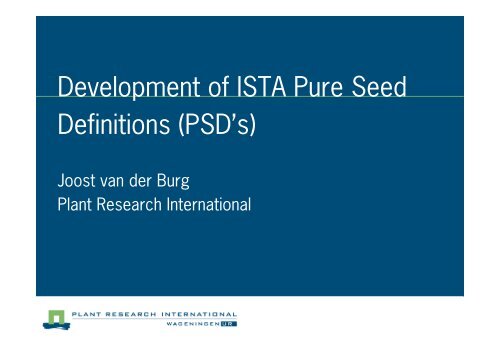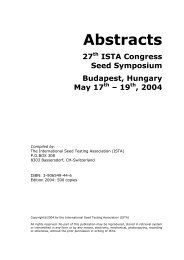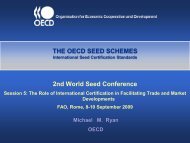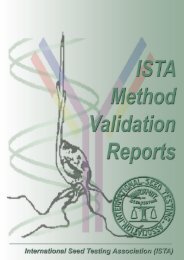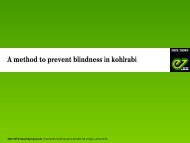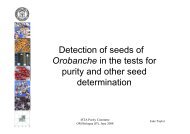Presentation Van der Burg 1 - International Seed Testing Association
Presentation Van der Burg 1 - International Seed Testing Association
Presentation Van der Burg 1 - International Seed Testing Association
Create successful ePaper yourself
Turn your PDF publications into a flip-book with our unique Google optimized e-Paper software.
Development of ISTA Pure <strong>Seed</strong><br />
Definitions (PSD’s)<br />
Joost van <strong>der</strong> <strong>Burg</strong><br />
Plant Research <strong>International</strong>
Contents<br />
<br />
<br />
<br />
Short history<br />
Consi<strong>der</strong>ations while developing PSDs<br />
Special cases<br />
Empty seeds<br />
Halfseed rule
History 1<br />
<br />
<br />
The first requests for purity tests (+ 1870) were made to<br />
combat adulterations:<br />
addition of stones and other nonseed material<br />
colouration of seeds and debris<br />
The first descriptions of pure seed were made to exclude:<br />
inert matter<br />
empty seeds<br />
seeds that will not germinate
History 2<br />
‘Crop seed definitions’ (MacKay, 1968)<br />
PSD’s introduced into the Rules in 1976<br />
Agricultural species: First PSD Handbook of 1978<br />
Many flower seeds included in the 2 nd edition 1987<br />
Forestry seeds in the FTS Handbook of 1991<br />
New PSD Handbook due in 2009 ..
Purpose of the purity test<br />
<br />
<br />
<br />
<br />
To describe what is to be found in the sample<br />
While doing that, we make quality judgements:<br />
we distinguish between pure seed and inert matter<br />
or: good and not good
Consi<strong>der</strong>ations<br />
The PSDdilemmas:<br />
what is possible in processing<br />
vs<br />
what is achievable in purity analysis<br />
what is relevant for practice / the user
The analyst’s dilemma<br />
Technical<br />
possibilities<br />
Economic<br />
consi<strong>der</strong>ations<br />
Technical<br />
demands<br />
Consumer<br />
preferences<br />
<strong>Seed</strong> <strong>Seed</strong> producer<br />
Consumer<br />
Price Price<br />
<strong>Seed</strong> <strong>Seed</strong> analyst analyst<br />
Technical<br />
possibilities<br />
Duration<br />
of of the the test test
Starting points<br />
<br />
<br />
<br />
<br />
‘User’ meaning the farmer as enduser of the seed<br />
The farming system: intensive/extensive<br />
(agric/vegetable/flowers/trees)<br />
The way of planting: broadcast/diff types of sowing machines<br />
The better equipped and managed companies
How to start developing a PSD?<br />
<br />
<br />
<br />
<br />
<br />
<br />
<br />
What is the norm / current practice in trade<br />
PSD’s for related species<br />
Botanical terminology<br />
Investigate what is possible with sorting<br />
What is technically possible in the lab? (blowers, sieves)<br />
What is possible ‘on the table’ (difficulty, time)<br />
Relevance for the germination test (sowing possibilities, PLS)
Strong Method (‘Continental method’)<br />
Quick Method (‘Irish Method’)
Strong Method<br />
Pure seed is:<br />
<br />
only seeds without any damage to vital parts
Strong Method<br />
Pure seed is:<br />
<br />
only seeds without any damage to vital parts<br />
Subjective<br />
Resulting in variation between analysts and labs<br />
Actually carrying out a germination test on the<br />
purity table
Quick Method<br />
Pure seed is:<br />
<br />
all pieces of seeds more than half the original size
Quick Method<br />
Pure seed is:<br />
<br />
all pieces of seeds more than half the original size<br />
More objective<br />
Less variation between analysts and labs<br />
Germinative capacity is determined in the<br />
germination test
1950:<br />
<br />
<br />
After decades of discussion it was agreed that the<br />
germination test will decide on germination:<br />
The presence of an undamaged embryo was no longer<br />
required<br />
So, the Quick Method won !<br />
<br />
Exception: empty seeds
Empty seeds<br />
<br />
<br />
<br />
‘… unless it is obvious that no seed is present’ (achenes,<br />
nuts, nutlets, mericarps, pods, etc.)<br />
Grass florets<br />
1/3 Rule (Festuca and Lolium)<br />
(Deleted for Elytrigia repens !)
Half seed rule<br />
<br />
The quick method: “> ½ of original size”<br />
what is > ½?<br />
<br />
<br />
<br />
what is original size?<br />
is seed coat relevant, or endosperm?<br />
do we need the embryo?
Half seed rule<br />
No radicle-plumule axis<br />
No testa<br />
Less than onehalf<br />
the original<br />
size with testa<br />
<strong>Seed</strong> completely<br />
without testa
Half seed rule<br />
>½ ≤½<br />
√<br />
PSD 10<br />
PSD 11<br />
√<br />
PSD 11<br />
(Fabaceae)<br />
√
So the apparently simplest rule proves not to be so simple to<br />
interpret after all ..
There is more to be said:<br />
<br />
<br />
<br />
<br />
Appendages<br />
Wings<br />
Envelopes<br />
MSU
Conclusion<br />
<br />
<br />
<br />
<br />
We shall avoid irrelevant details<br />
We must keep them easy to interpret<br />
We shall remember that if a unit is almost like a seed, it will<br />
be sown as such<br />
We must also keep in mind that we have a germination test<br />
after this
Thank you


